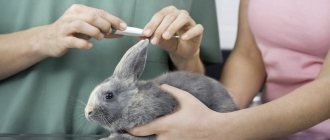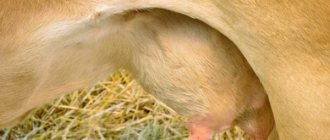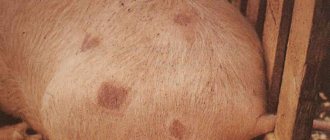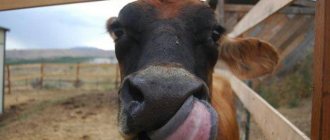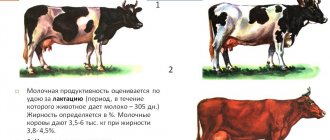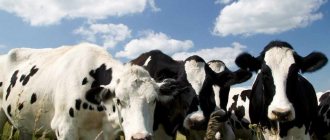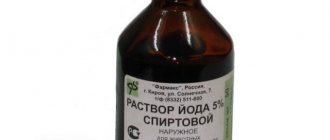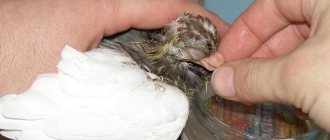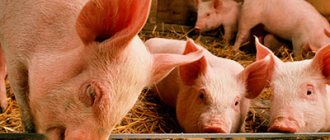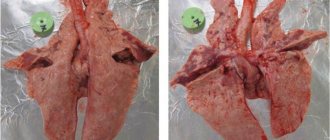Causes and routes of infection
If sanitary standards are not observed, the probability of infection with trichophytosis is more than 90%. The disease is very quickly transmitted from a sick animal to a healthy one.
Among the main causes of morbidity are the following:
- poor disinfection of equipment;
- dampness in the room;
- lack of space;
- lack of light;
- lack of vitamins;
- poor quality care.
Did you know?
Young individuals are most susceptible to the disease . With trichophytosis, calves gain weight poorly and have disturbances in the functioning of the central nervous system.
The disease spreads even during the incubation period, when there are no obvious manifestations of the disease on the cow’s body.
Reasons why lichen occurs
The main reason why this unpleasant illness can occur is contact with sick animals, as well as non-compliance with sanitary and hygienic conditions. The fungus also enters through wounds, minor abrasions, and scratches. It is not difficult to notice ringworm in a cow or calf.
At the site of the lesion, peeling and crusting first appear, then hair falls out, which is clearly visible in the photo provided at the end of the article. The causative agent of the disease, the trichophyton fungus, develops very quickly in the cells of the epidermis and blocks the hair follicles. In case of contact with skin, the first symptoms may develop after 5-7 days.
It is important to note that in addition to external problems, lichen has a bad effect on the health of animals. Thus, in young cattle and calves it inhibits growth and development. In adult cows it often causes exhaustion and decreased productivity.
Symptoms and locations
Manifestations of lichen are difficult to miss.
The picture of the disease is as follows:
- The skin at the site where the microorganism is introduced becomes severely peeling.
- At the site of future baldness, a gray coating appears.
- The hair on the affected area falls out. It looks like it was cut off at the root.
- Round or oval bald patches appear on the cow's body.
Often the disease is localized on the back, neck and face of the animal. If the immune system is weakened, the patches spread throughout the body. Lichen practically does not affect the legs and udder.
Unpleasant and dangerous symptoms
The pathology is characterized by pronounced symptoms, which is why it is difficult to confuse it with other ailments. If in doubt, it is worth consulting a veterinarian who can tell you what ringworm looks like and make the correct diagnosis.
Infection of livestock with a fungal infection can be recognized by the following signs:
- peeling of the skin in the area affected by the pathogen;
- the appearance of a gray coating on the fur - subsequently these areas become bald;
- hair loss in the form of hairs cut off at the root - this is caused by damage to the follicles by fungi;
- the appearance of bald spots - they have a round or oval shape and differ in size.
See also
The causative agent and symptoms of leukemia in cattle, how it is transmitted and the danger to humansRead
As the pathology develops, the animals become more aggressive and irritable. This is due to constant itching. In addition, infected calves appear emaciated. This is due to loss of appetite and deterioration of digestive functions.
If you do not start therapy on time, your health will worsen. If a secondary infection is added to lichen, there is a possibility of death of the affected animal.
Diagnostics
To diagnose trichophytosis, the first step is to conduct an external examination of the cow. The characteristic clinical signs of ringworm are revealed.
Important! You should not rely only on external manifestations. Similar symptoms are observed in scabies and dermatitis.
If symptoms are present, scabs or hairs from the affected area are sent for mycological examination. The laboratory determines the type of fungus in order to select the appropriate treatment.
Etiology
The causative agent is a microscopic fungus of the genus Trichophyton. In cattle, Tr. verrucosum, in horses Tr. Egwinum, in pigs and carnivores Tg. Gypseum.
Examining the mycelium of the fungus with microscopy, it is clear that it is located in rows along the hair and on the surface layer of the skin, and also has the appearance of a thin branched thread. Near the hair root, the fungus produces round or oval spores.
The mushroom is sown on Sabouraud medium, Litman agar. Cultivated at 26-28°C. The growth is gray with a pink color, even or slightly folded, clearly visible on the 5th day.
The pathogen is stable in the external environment. On hair and skin it persists for up to 8 years, in pathological material for up to 2 years, on care items and indoor surfaces for 3-5 years, in manure for up to 7 months, in soil for up to 4 months. Resistant to low temperatures. Boiling kills within 2 minutes, heating to 80 °C for 7-10 minutes, dry steam 110 °C for 1 hour.
Classic disinfectants (formaldehyde, alkali, carbolic acid) kill within 20-30 minutes.
The source of infection is sick and recovered animals. Rodents also carry the pathogen. Infection occurs through direct contact. Transmission factors include contaminated feed, care products, equipment, and maintenance personnel. Dogs often become infected while walking from homeless people in densely populated areas. Most often, infection occurs in the spring.
Having settled on the skin, fungi quickly grow into the epidermis and hair follicles, disrupt tissue trophism and cause a clinical picture.
How to treat lichen
Trichophytosis is treated in several ways. The treatment strategy depends on the form of manifestation and the degree of infection by the fungus. At the initial stage, you can get by with antifungal ointments and keratolytic drugs. In case of large-scale lesions, vaccination of the animal is added to the treatment plan.
Disinfection of the premises
Any treatment will be useless if the feeding area and stall are not disinfected. As mentioned earlier, fungal spores persist in the external environment for many years. To avoid the growth of fungi, it is necessary to disinfect equipment, feeders, floors and walls.
Used for processing:
- 5% formaldehyde solution;
- carbolic solution;
- 20% bleach solution.
To treat the premises, the disinfectant consumption will be 1 liter per 1 square meter.
Vaccine for cattle
Vaccination is an effective preventive measure and also promotes a speedy recovery of sick individuals.
In modern farming, drugs such as:
- SP-1;
- TF-130;
- LTF-130.
The vaccine contains a sterile culture of the fungus. Once in the animal’s body, the drug promotes the formation of immunity to lichen pathogens.
Calves up to six months old are vaccinated. Immune protection is formed in the first 2 weeks after administration of the vaccine and lasts for 7 years.
Important! The vaccine has absolutely no effect on the quality of milk.
Antifungal ointments
Antifungal ointments kill pathogens at the site of infection.
The following tools have proven themselves to be effective:
- Fungin in the form of a suspension or spray;
- Yam Fungibak;
- Imaverol in the form of a suspension;
- Zoomikol in the form of a spray;
- Unisan Forte.
During treatment, it is necessary to give the animal immunostimulants.
Keratolytic agents
Keratolytic drugs are prescribed in combination with antifungal ointments:
- 10% iodine solution;
- 10% solution of brilliant green.
- salicylic acid;
- Sulfuric ointment;
- tar ointment.
They ensure regeneration of the epidermis.
Folk remedies
Folk remedies for treating affected areas:
- a mixture of turpentine and tar (2:1);
- 20% solution of copper sulfate;
- a mixture of sulfur, lime and copper sulfate (3:2:1).
Celandine and garlic juice are also used.
Cattle skin diseases also include abscesses and warts on the udder.
Vitamin supplements
To increase immunity, a large amount of vitamins A, B, E and mineral elements are introduced into the cow’s diet. Intramuscular vitamins such as Gamovit and Ligfol may be prescribed.
Diagnosis and treatment
The cause of the disease is identified by examining the sick animal. To confirm the diagnosis, microscopy of crusts, scales and hairs is performed. The hair should not be cut, but pulled out, because trichophytons prefer to live in the bulbs.
Sick animals should, if possible, be isolated from healthy ones. The treatment strategy depends on the form of the disease, age and develops in the following areas:
- external antimycotics;
- immunization;
- treatment of concomitant diseases
External antimycotics
Antimycotic drugs are used, most often, in combination with keratolytic drugs. How to treat lichen? Before using an antifungal agent, it is necessary to remove dirt, crusts and other obstacles to the action of the active substance. The antimycotic component works more effectively if the animal’s skin is cleansed, softened and steamed. Keratolytic drugs help to reject the affected epidermis and replace it with a new one, free of fungus. The following funds are in demand:
- Ointment Yam. Antimycotic, antimicrobial and astringent components of the drug, when applied twice to the affected areas of the animal's skin within a week, allow the crusts to peel off. The first signs of successful treatment of lichen in a cow are considered to be the beginning of hair regrowth.
Ointment YAM BK
- Zoomikol. The active substance of the drug, Thiabendazole, inhibits the reproduction of micromycetes. The spray is sprayed evenly over the affected area, covering 1–2 cm of healthy skin. The drug is reapplied after 3–5 days. 3-4 treatments are required.
- Imaverol. The drug is produced in the form of a thick yellow-brown concentrate, from which, by adding fifty times the volume of warm water, a working emulsion is prepared, which must be used within a day. Treatment of lichen consists of four treatments of pathological lesions, which are carried out at three-day intervals. Initially, using a sprayer, apply the working emulsion to the entire surface of the body. More than a liter of mixture is consumed per adult animal. Subsequently, the affected area is treated, capturing a strip of healthy skin.
Imaverol
- Fungin. Produced as a solution or aerosol. The source of lichen spread with surrounding healthy tissues is treated daily for two weeks.
- Keratolytic drugs:
- Salicylic acid solution.
- Tar ointment.
- Copper sulfate 20%.
- Tincture of iodine.
- Diamond green.
- Iodoform.
- Sulfuric ointment.
Keratolytics alternate with antimycotic drugs. For example, when treating lichen at home, ointments or solutions are used in the morning, substances that stimulate the growth of new tissue in the evening, or vice versa. Treatment with external agents must be carried out wearing protective clothing and gloves.
Immunization
In severe situations, when external preparations are ineffective, an antimycotic vaccine is used for medicinal purposes. Immunization against lichen in cattle is carried out with the drug LTF-130 or another, administered intramuscularly with revaccination after 2 weeks. This technique allows you to inactivate the fungus and prevent its further spread. Injections of fat-soluble vitamin preparations—Trivit, Tetravit, etc.—have an immunostimulating effect. To increase the effectiveness of treatment, the diet is revised to increase its caloric content and saturation with nitrogenous substances, and also bring zoohygienic conditions to compliance with the recommended standards.
LTF-130
Treatment of concomitant diseases
In some situations, lichen in a cow is not the root cause, but a secondary factor, when the body, weakened by another disease, remains defenseless against micromycetes. In this case, the use of a drug against the underlying disease, for example Ivermek, has a positive effect on the condition of the skin.
Sometimes micromycetes weaken the body, and it becomes vulnerable to attack by carpet beetles or parasitic roundworms. In this case, the drug Ivermek eliminates additional pathology and facilitates the course of Trichophytosis. In cattle hypodermatosis, the larva preparing to emerge from under the skin causes inflammation along the edges of the resulting fistula. The affected area is contaminated by a fungus. And with this disease, a drug based on Ivermectin helps.
Ivermek
Ringworm does not only affect large ruminants. There are known cases of infection of goats, sheep, and horses with a pathological fungus. Sometimes it is difficult to make a diagnosis - what disease does the animal have? Trichophytosis or dermatitis caused by another reason. In any case, the use of Ivermek alleviates the suffering of animals.
Severe dermatitis in dogs is caused by cases where several infectious principles are at work. For example, with demodicosis, subcutaneous mites, banal bacterial microflora and the Trichophyton fungus have a pathological effect. In such cases, as well as for other contagious dermatitis, Ivermectin is used. The drug must be used carefully, under the supervision of a veterinarian, because it is contraindicated for dogs of the Sheltie, Bobtail, and Collie breeds, as it causes a disease that ends in death.
Prevention
Preventive measures include:
- compliance with sanitary and hygienic standards;
- regular inspection of cows;
- disinfection of the premises;
- animal vaccination.
The most dangerous thing about trichophytosis is the speed of spread, so sufficient time should be devoted to preventing the disease. If, nevertheless, the disease manifests itself, it is impossible to delay treatment under any circumstances. Remember that the disease affects animals en masse and can be transmitted to humans.
Symptoms
The incubation period lasts from 5 to 25 days. In cattle, lesions of ringworm initially appear on the head and neck, then move to the chest area, and occasionally to the croup. Adult cattle suffer from the disease in a superficial form; the lesions are small, limited, with gradual even growth in different directions. Over time, the center becomes covered with small crusts ranging from gray to yellow. When the epithelium is cleared, a hairless space remains. The skin thickens and becomes folded. The pathology is accompanied by itching, which contributes to the transfer of the fungus to other parts of the body. Sometimes the lesions merge, forming large areas.
If scratching is accompanied by a violation of the integrity of the skin, secondary microflora joins and the process can turn purulent. In this case, the place of lichen becomes covered with thick crusts with dried discharge. Young animals lose appetite and lag behind in development.
In horses, the head, neck, back, tail area, and sometimes the limbs and abdomen are affected. The disease is accompanied by severe itching. The hair becomes tousled, breaks off and exposes regularly shaped areas of skin with an overlay of epithelial scales.
Small cattle usually get sick at the age of 1-2 years. Typical lesions are located on the back, neck, and shoulder blades.
Pigs are rarely affected by the fungus. Localization sites become red and round with a significant amount of brown epithelium. There is practically no itching and it ends with self-healing.
In carnivores, the head, neck, limbs, and base of the tail are affected. The spots are round, small, then merge, capturing increasingly larger spaces. Hair is easily pulled out, scratching is observed, the skin thickens and becomes covered with folds.
